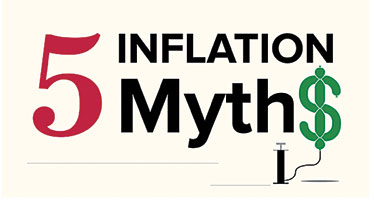 With the issue of inflation raising prices that impact all working families, some popular reasons for it gaining traction have not been grounded in the data.
With the issue of inflation raising prices that impact all working families, some popular reasons for it gaining traction have not been grounded in the data.
Economic Policy Institute research sets the record straight on the causes of inflation – and how policymakers can best restrain it. Here’s debunking of the top five inflation myths:
• Myth #1: Workers’ wage growth is driving inflation. Nominal wage growth – while faster relative to the recent past – has lagged far behind inflation, meaning that labor costs have been dampening, not amplifying, inflationary pressures all along.
• Myth #2: Corporate profits are not contributing to inflation. In fact, fatter corporate profit margins drove over half of the increase in prices in the non-financial corporate sector between the second quarter of 2020 and the end of 2021. This is not normal. From 1979 to 2019, profits contributed only about 11 percent to price growth. Ignoring the role of profits makes inflation analyses a lot weaker.
• Myth #3: Federal relief and recovery measures overheated the economy and fed inflation. Evidence from the past 40 years suggests strongly that profit margins should shrink and the share of corporate income going to labor compensation should rise as unemployment falls and the economy heats up. But the exact opposite pattern has happened so far in the recovery – casting much doubt on inflation expectations rooted simply in claims of macroeconomic overheating. In short, the labor market is strong, but it’s not overheating.
• Myth #4: Removing import tariffs would be a major tool to fight inflation. Tariffs were put in place far before early 2021, when inflation began rising, and eliminating tariffs could not significantly restrain it. Further, removing tariffs would not be costless. Tariff removal could result in job losses, plant closures, cancellations of planned investments, and further destabilization of the domestic manufacturing base, which would increase domestic dependence on unstable import supply chains.
• Myth #5: Investments in child and elder care would accelerate inflation. In fact, investments in child and elder care could help restrain inflationary pressures. By subsidizing families’ use of child and elder care, such investments could boost future labor supply by allowing parents or elders’ caregivers to look for paid employment while remaining confident their family members are receiving care.
(The Economic Policy Institute (EPI) is a nonprofit, nonpartisan think tank that focuses on the economic interests of workers in research and policy debates in the United States. EPI is widely recognized for its authoritative analyses of economic inequality and is a key institution in the movement for economic justice.)


